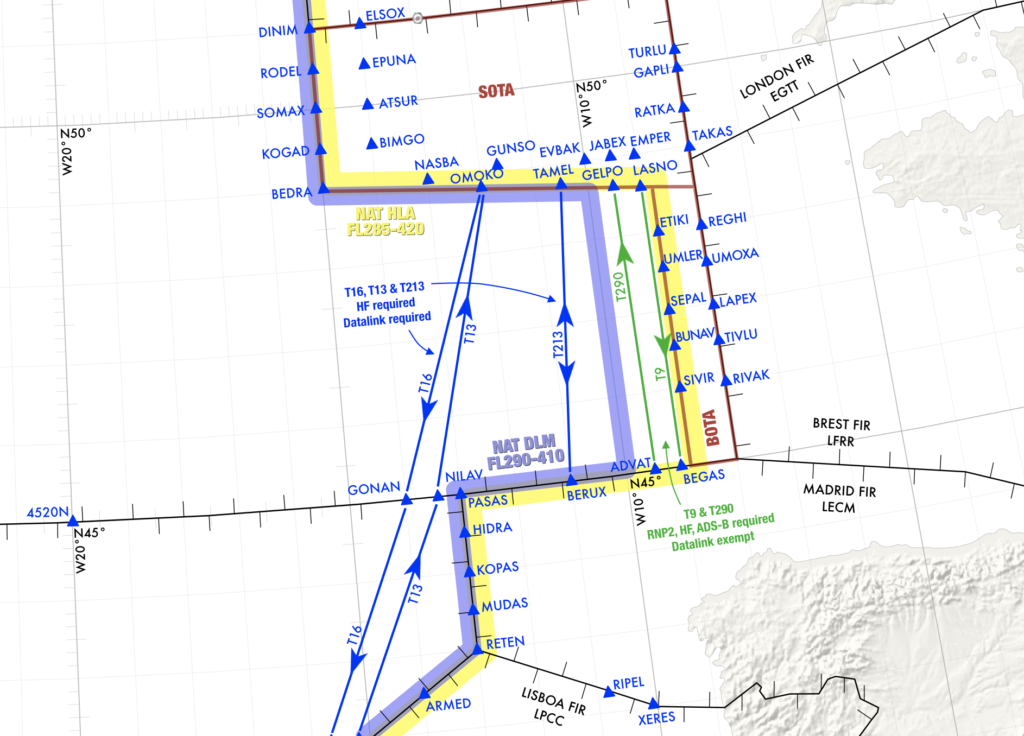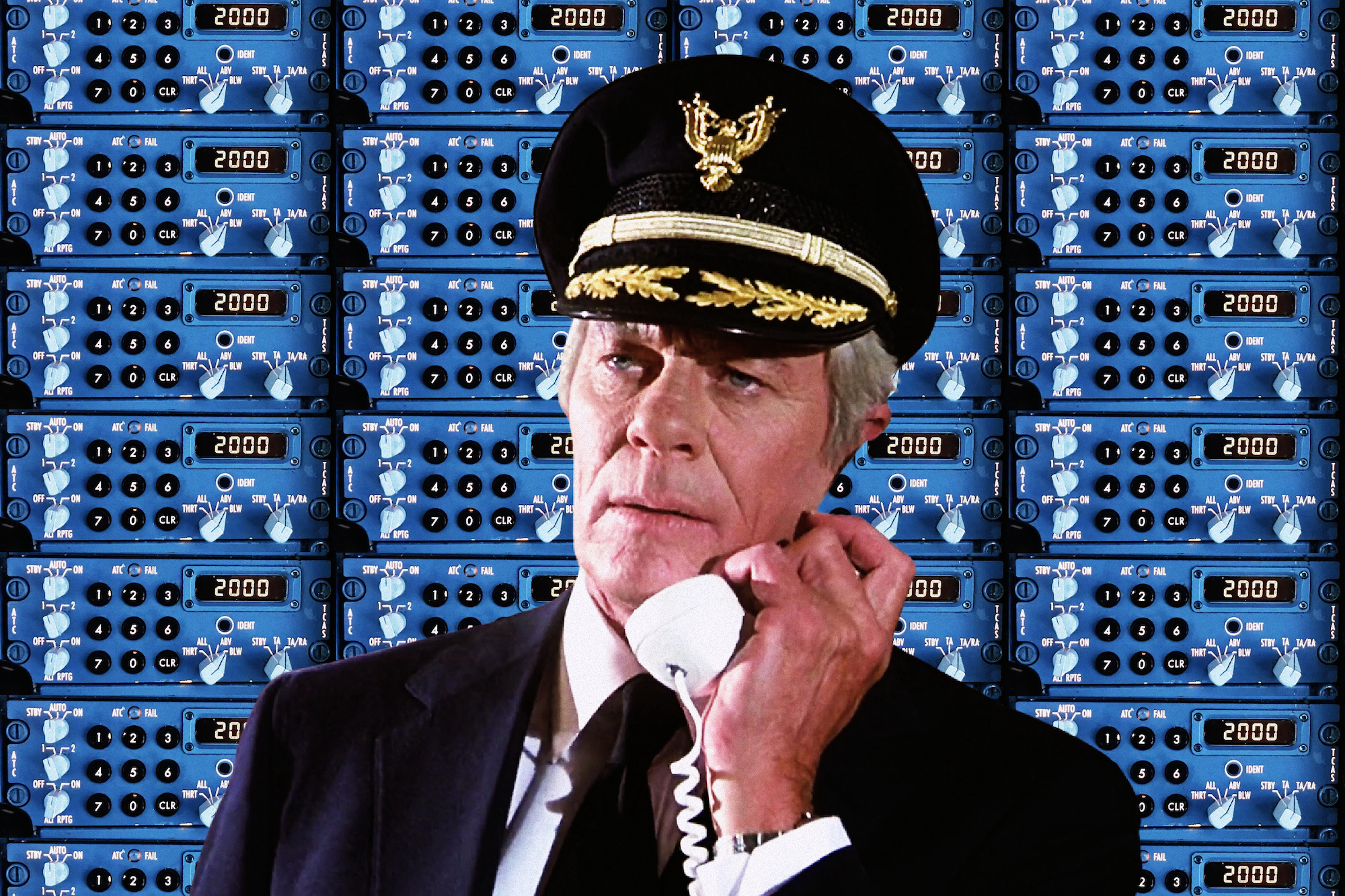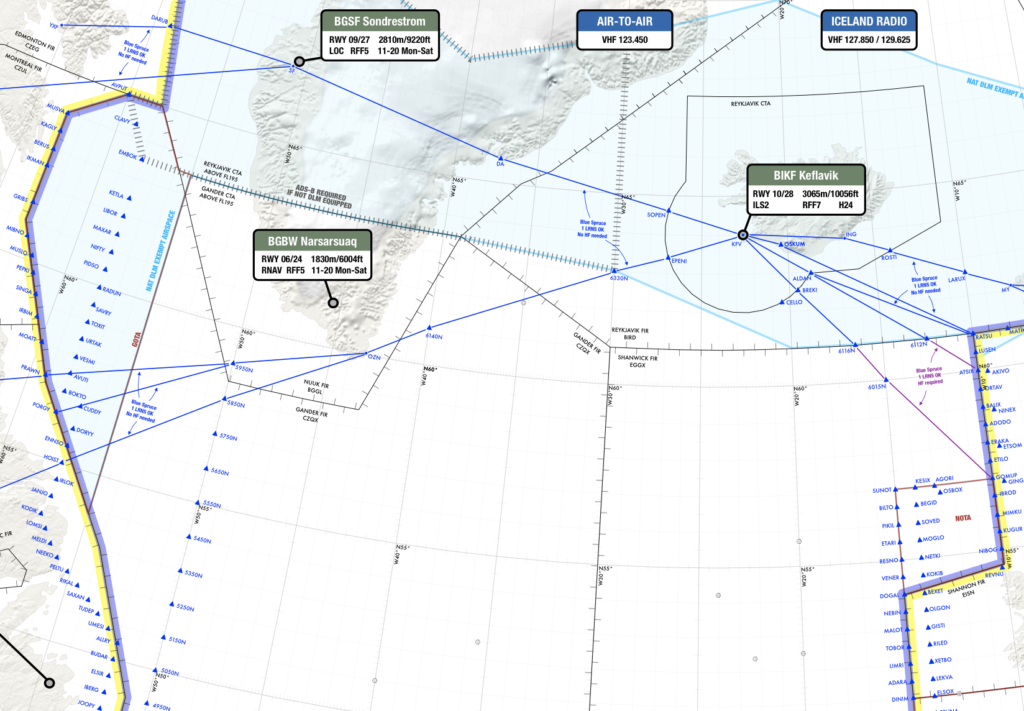The NAT Region is changing the “last assigned code” SSR transponder procedures. Since the dawn of time, everywhere on the NAT, this domestic code had to be retained for 30 minutes after entering NAT airspace. But now the UK has changed it to 10 minutes for the entire EGGX/Shanwick FIR, and we expect all the other NAT FIRs will soon be updating their rules to say the same. This new 10-minute rule will then become the standard across the NAT Region, and will be published in the next version of the NAT Doc 007 due out in October 2023.
For several decades, unless directed otherwise by ATC, pilots flying in the MNPS airspace, now known as the NAT, were required to maintain the transponder in Mode A/C with continuous Code 2000 operation, except for the last assigned code, which had to be retained for a period of 30 minutes after entering the NAT airspace or leaving a radar surveillance service area.
The rationale for changing from the last assigned code to Code 2000 after 30 minutes was based on the recognition of the original domestic code by subsequent national radar services upon exit from the oceanic airspace.
It was crucial to make this change before exiting, in line with the terms of ICAO Doc 4444: “Except for aircraft in a state of emergency, or during communication failure or unlawful interference situations, and unless otherwise agreed by regional air navigation agreement or between a transferring and an accepting ATC unit, the transferring unit shall assign Code A2000 to a controlled flight prior to transfer of communications.”
Thus, due to the limited time spent in the NAT HLA, when flying on Tango 9, Tango 290, or Tango 213, the change from the last assigned domestic code to Code 2000 should occur within a maximum of 10 minutes after passing BEGAS, ADVAT, or BERUX when Northbound, and LASNO, GELPO, or TAMEL when Southbound

The Tango Routes
For the same reason, aircraft with a routing sequence Reykjavik-Shanwick-Scottish (BIRD-EGGX-EGPX) shall change the last assigned code to Mode A 2000 on transfer from Reykjavik and no later than 10 minutes after entering Shanwick airspace.
It should also be noted that Reykjavik ACC provides radar control service in the southeastern part of its area, and therefore, transponder codes issued by Reykjavik ACC must be retained throughout the Reykjavik OCA until advised otherwise by ATC.
Furthermore, although outside the NAT HLA, it is also necessary to retain the last assigned code in New York West ATS airspace. Similarly, aircraft transiting Bermuda RADAR airspace should remain on the last assigned code until clear of that airspace, then squawk 2000.
In all other cases, Code 2000 would be displayed 30 minutes after entry into the NAT airspace.
So what has changed?
In its AIRAC 2023-06-15 edition, the UK AIP ended the 30-minute code retention rule in order to standardize a change to Code 2000 after 10 minutes of entering the NAT airspace.
The UK AIP now states:
“Unless otherwise directed by ATC, aircraft equipped with SSR transponders in the NAT region shall operate transponders continuously on Mode A Code 2000 regardless of the direction of flight, except that the last assigned code shall normally be retained for a maximum period of 10 minutes after entry into NAT airspace.”
This change eliminates the exceptions for Tango routes.
Why didn’t I hear about this?
The change was buried deep within the UK AIP without any publicity or modification of specific NAT documents – notably the famed NAT Doc 007.
The North Atlantic Document 007 is regularly updated through the ongoing efforts of the North Atlantic Special Planning Group (NAT SPG). While it does not establish regulations (which fall under the Regional Supplementary Procedures DOC 7030 and FIR-specific AIPs), it is widely regarded as the primary resource for operational guidance in the North Atlantic. So it was surprising to learn that it had not been updated following the recent change in the Shanwick FIR, despite the ongoing work of the NAT SPG.

Sometimes even big changes can be tricky to find…
One could have expected that a change to a long-established practice (even if understandable for the purpose of standardizing a rule and eliminating exceptions) would have been anticipated and coordinated to avoid introducing a new exception distinguishing one FIR from the others.
But after verifying with NAT specialists at Shanwick, it appears that they have been talking about it with all the other FIRs – and everyone has agreed to change the rule to 10 minutes. This change will be published in the next version of the NAT Doc 007 (expected Oct 2023), and all other FIRs will be updating their AIPs in due course. It’s apparently part of a push to harmonize NAT Region procedures where possible.
The delayed implementation of Oceanic Clearance Removal (OCR) resulted in a delay in the publication of the NAT Doc 007, as it required significant changes to support OCR. While the 10-minute change has been universally accepted by all Air Navigation Service Providers (ANSPs), the lag between documentation and ANSPs is solely due to the delayed updates of Doc 007 being published.
So tell me again, what has changed?
- In the entire NAT airspace under Shanwick’s jurisdiction, unless instructed otherwise by ATC, the last assigned transponder code must be retained for 10 minutes, followed by displaying Code 2000.
- When arriving eastbound from BIRD/Reykjavik to EGGX/Shanwick enroute to EGPX/Scottish, Code 2000 should be displayed upon transfer from Reykjavik to Shanwick and no later than 10 minutes after entering Shanwick airspace.
- In the other NAT FIRs (CZQX/Gander, KZWY/New York, LPPO/Santa Maria, BIRD/Reykjavik, ENOB/Bodo), the 30-minute rule still applies… until it changes!
More on the topic:
- More: NAT Crossing after GPS spoofing: a guide
- More: NAT Doc 007 – New Edition
- More: Don’t Climb! A Big NAT No-No
- More: Oceanic Clearance Removal mess – Version 4!
- More: NAT Clearance changes – a game! (V4)
More reading:
- Latest: Teterboro: RIP the RUUDY SIX
- Latest: 400% increase in GPS Spoofing; Workgroup established
- Latest: GPS Spoofing WorkGroup 2024
- Safe Airspace: Risk Database
- Weekly Ops Bulletin: Subscribe
- Membership plans: Why join OPSGROUP?












 Get the famous weekly
Get the famous weekly 






Hi All,
Would it be possible to share some thoughts on the following? New York seems to have changed time from 30 to 10 minutes this week and I can no longer find the requirement to remain on the last assigned transponder code in the WAT Area. What your guys thoughts on this?
If T290 is a Northbound-only route, even accordingly with UK’s AIP, why is it that at Doc 007 they say we have to sqwak 2000 10 minutes after GELPO when flying Southbound. The same applies for T9, since it’s a Southbound-only route, when they say we have to sqwak 2000 10 minutes after passing BEGAS in a Northbound route.
This has been going like these since, at least, 2020, when T290 was created.
It’s, somehow, a sign that the North Atlantic Systems Planning Group (NAT SPG) doesn’t work in close proximity to the respective countries Air Service Providers and/or Aeronautical Authorities.
Excellent ! Tk u Alec !-)